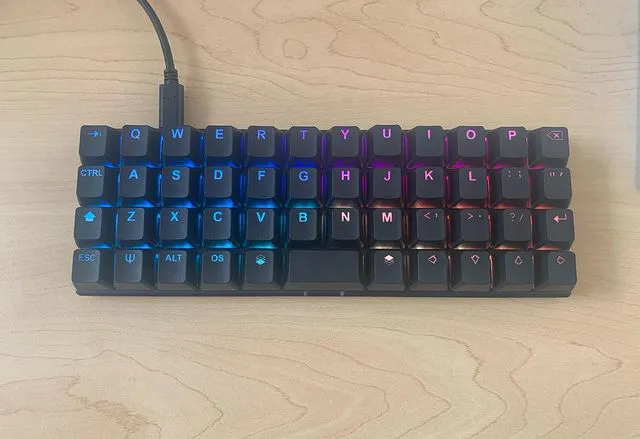Notes on building mechanical keyboards

The keyboard in the picture is my Planck EZ. I explored about building keyboards (and will hopefully do this someday).
~ This is a rabbit hole ~
Places that sell stuff
- KBDFans
- TechKeys for keycaps and some weird goodies like 1-key keyboards
- SpaceCat - apart from other things has an Alpha PCB to build a sample keyboard. Might be better to get a Gherkin from MechBoards.
- MechBoards has some good kits. The Iris kit and Lets Split kit are good. Compare the cost when buying.
- keeb.io has kits and guides
- 1upkeyboards
- PimpMyKeyboard
- kprepublic.com
- Sentraq
- CannonKeys sells some inexpensive practice kits
- KeyHive has a $18 Maypad practice kit
- Happy Hacking Keyboard (HHKB) and Leopold F660C
- Both are expensive.
- Both use Torpe switches.
- GeekHack has a list of keycap sellers
- CandyKeys has a lot of keycaps and switch options
- JellyKey
- X-bows keyboards
- MechanicalKeyboards
- Check AliExpress and NewEgg too
Notes for custom builds
Case & PCBs
- Check if the PCB has LEDs or if it atleast supports it. SMB LEDs are the kinds of LEDs that I’ve come across so far - flat and can be soldered to PCB.
- Get a Tofu65 case with a KBD67 PCB.
Key switches
- Gateron can be better than Cherry MX.
- Browns are better for me.
- Checkout low-profile switches (comes in both optical and mechanical variants).
- Sometime tryout Holy Panda or Glorious Panda switches.
Keycaps
- Keycaps come in various sizes. 1u and 2u are common. Check size before buying.
- Check if the keycaps work with the key switch being used.
Controller
- Use an Elite-C controller which is a clone of SparkFun Pro Micro, but with a USB-C instead of micro-USB. Pro Micro is cheaper but the usb port has a reputation of getting ripped off the board.
- QMK firmware supports a number of keyboards
- QMK supports Atmel and AVR ICs. Infact the Pro Micro is an Arduino clone. Maybe I can use one of the Arduino boards? (QMK seems to support ATMEGA328up)
- What if I used my own controller?
- There is a possibility of using a Teensy microcontroller. But again it’s micro-USB.
- SeeedStudio Xiao is cute (like a Tomu with pin-outs). But the cortex-based chip used by the Xiao is not supported by QMK.
Kits
- Check if case and keycaps are being sold with the kits. Else have to buy them.
Other people’s notes on making keyboards
- 40percent.club is a blog about building keyboards
- Building a keyboard matrix
- NematicsLab has some electronics tutorials
- technomancy’s notes on building atreus